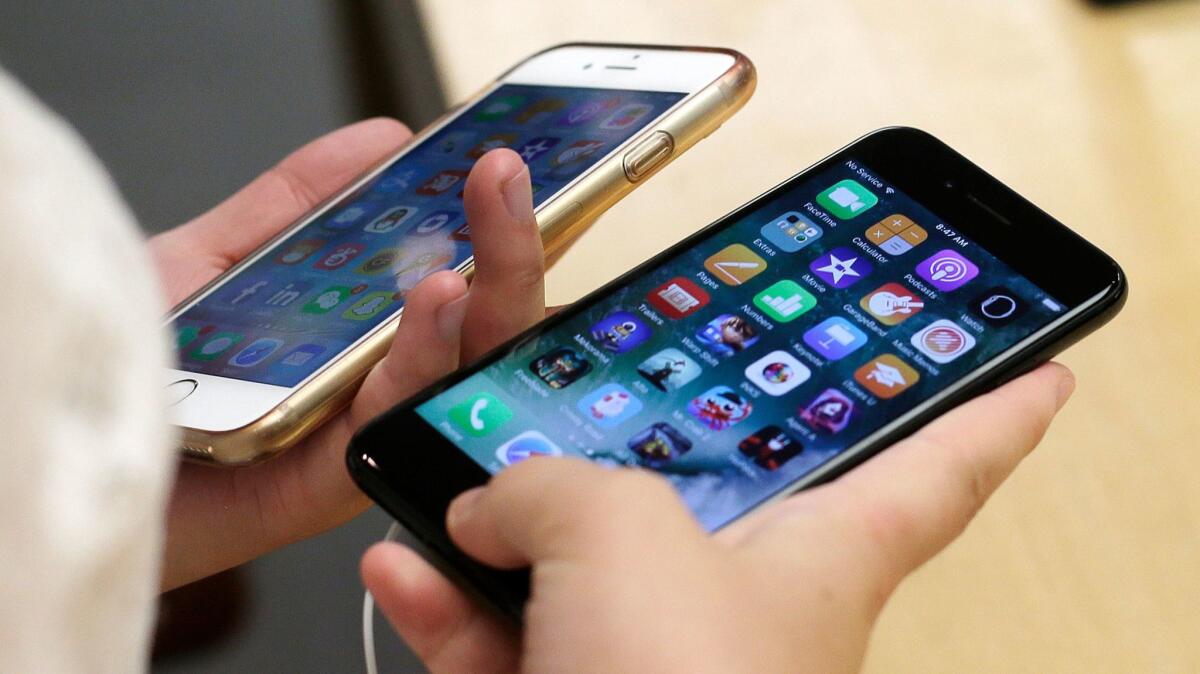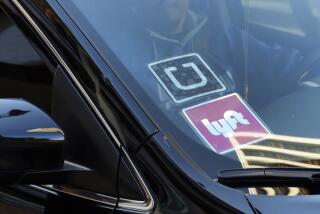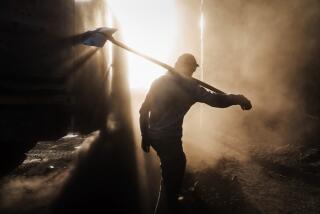Op-Ed: Were the raw materials in your iPhone mined by children in inhumane conditions?

- Share via
Last year, I visited the sprawling mines of Cerro Rico, the “rich hill” that looms over Potosi, Bolivia. Four centuries ago, it supplied the silver that bankrolled the Spanish empire. Today, miners who work in the same tunnels as 16th century conscripted Incan laborers are providing tin for Apple products like the iPhone. It’s a powerful paradox — our most cutting-edge consumer devices are made from raw material obtained by methods barely advanced beyond colonial times.
Cerro Rico couldn’t be farther from Silicon Valley. Cigarette-scarred devil idols mark the mine entrances. Its support beams are split and cracked, and the air in the tunnels is thick with suffocating silica dust. According to a BBC report, the average lifespan of a Cerro Rico miner is 40 years. Worse, a UNICEF report found that children as young as 6 years old have worked in its tunnels.
For the record:
9:49 p.m. Feb. 21, 2025A quote about the metal gallium has been clarified in this piece. It is not the only metal that is liquid at room temperature, but it is the only metal in the iPhone that is liquid at room temperature.
Tin isn’t the only ingredient in an iPhone that’s obtained in ways that don’t quite match Apple’s “Supplier Code of Conduct,” which states that “all workers in our supply chain deserve a fair and ethical workplace.” In an effort to trace the origins of the iPhone I broke one — literally — into its basest elements. Among the things that became clear: Despite Apple’s not insignificant efforts, the richest, most influential player in the technology industry isn’t doing enough to protect the workers that provide the fundamental ingredients in its products.
Miners are risking their lives to provide you with a device that lets you read this while you’re waiting in line for the bathroom.
My project started with a rock crusher and the help of David Michaud, a mining consultant with 911 Metallurgist in British Columbia. We smashed an iPhone 6, pulverizing it, and then analyzed the resulting dust using mass spectometry, X-ray fluorescence and infrared analysis. Our efforts yielded a richly detailed list of what makes up the iPhone’s 129-grams.
The phone contained 31 grams of aluminum, nearly a quarter of its total weight. That was a little surprising, given how light aluminum is, but it’s fitting that the most abundant metal in the Earth’s crust is also the most abundant metal in the iPhone. Carbon and oxygen — found in the phone’s plastics and its battery — ranked second and third in the elemental lineup, followed by iron.
We tallied more than 6% silicon (microchips), 6% copper (wiring) and more than 5% cobalt (a primary ingredient in the lithium-ion battery). Tin accounted for only about half a percent of the iPhone’s total mass; it was used as the soldering agent, to fix the components in place.
The analysis also returned some unexpected findings — trace amounts of arsenic in the processor, and the element gallium. “It’s the only metal” in the phone, Michaud says, “that is liquid at room temperature.”
According to Michaud’s calculations, to obtain the 100 or so grams of minerals found in a single iPhone, miners around the world have to dig, dynamite, chip and process their way through about 75 pounds of rock. On just about every continent, many of those miners are risking their lives to provide you with a device that lets you read this while you’re waiting in line for the bathroom.
For example, the mud pit mines on Indonesia’s Bangka Island, another source of tin for Apple, are arguably even deadlier than the Cerro Rico complex. Miners there have been swallowed by landslides and collapsing pits; six died in one week in 2012. In 2014, after a BBC report about Bangka, Apple sent a task force accompanied by an environmental NGO to investigate. It’s unclear if conditions have changed much on Bangka, but according to its most recently published reports, Apple is still sourcing tin from the island’s mud pits.
The Dodd-Frank Act of 2010 requires companies to identify the smelters that supply them with four “conflict” minerals — tin, tantalum (.02% of the phone), tungsten (also .02%) and gold (.014%). (The market for these substances funds warfare in and around the Democratic Republic of Congo.) Apple has complied. In 2014, it declared its tantalum suppliers conflict-free. In 2016, it announced that 100% of its smelters had submitted to third-party audits for fair practices. (It had already cut off a number of them for noncompliance with its code of conduct). However, by interviewing miners and tin industry analysts, I was able to link child labor-plagued Cerro Rico to a smelter Apple was still using in 2016 — clearly, third-party audits only go so far.
Every other year or so, a new revelation of terrible mining conditions seems to send the company scrambling. In 2016, the Washington Post revealed that “artisanal” mines in Congo, a prime source of cobalt for Apple and other companies, employed children and adults who dig by hand hundreds of feet into the earth for subsistence wages. Apple mapped its cobalt supply chain and promised to clean it up. But it wasn’t until Sky News aired footage of children working in the Congolese mines this year that the company pledged to cut off the source.
Of course, Apple isn’t alone in obtaining minerals from troubled mines and conflict zones. And it is undoubtedly true that establishing a clean, ethical supply chain is an enormous challenge. At Cerro Rico, for example, underage miners work in what you might call freelance cooperatives. They pool the ore they take from the mines and sell it to a middleman who in turn provides it to the smelter. The road from child-mined tin to an iPhone component is anything but direct and easy to police.
To effect real change, companies must dedicate serious resources and novel systems-thinking to the problem. And if any company has serious resources to spare it’s Apple: It’s the most valuable enterprise in the world, with $256 billion in cash on hand. Apple recently said it would like to end its reliance on mining altogether, and to its credit, it has experimented with solutions such as automated recycling. (Its impressive recycling robot, Liam, can disassemble used iPhones and harvest their parts.) But so far these projects are merely aspirational.
If Apple expects to live up to its code of conduct, it needs to spend more of its billions to aggressively map and proactively investigate where all its elements come from, getting past the smelters and into the mines at places like Cerro Rico. When Steve Jobs introduced the iPhone, he said, “It works like magic.” Now Apple should turn its predilection for innovation and just-so design toward creating a state-of-the-art sustainable, ethical beginning-to-end supply chain — and a phone that is as humane to build as it is magical to use.
Brian Merchant, an editor at Motherboard, is the author of “The One Device: The Secret History of the iPhone.”
Follow the Opinion section on Twitter @latimesopinionand Facebook
More to Read
A cure for the common opinion
Get thought-provoking perspectives with our weekly newsletter.
You may occasionally receive promotional content from the Los Angeles Times.









